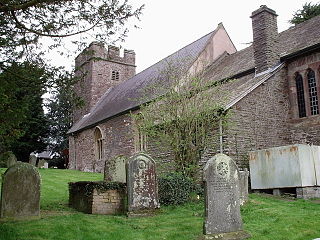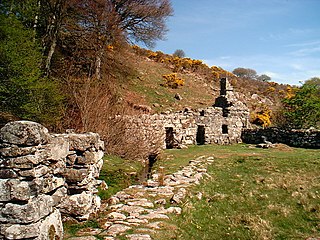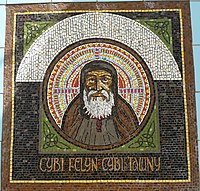Life in Cornwall
The vita of Cybi, found in two (Latin) forms written about 1200, is of very doubtful value, but may be right in making him the son of a Cornish noble who was princeps militae, at a court between the Tamar and the Lynher, possibly Gelliwig. [3]
According to the 'Life of Saint Cybi', he was the son of Salomon, a 'warrior prince', generally thought to have been a King of Cornwall. In the 'Bonedd y Saint', his father's name is given the Welsh form, Selyf. His mother, Saint Wenna (Gwen ferch Cynyr), was sister to Saint Non. [4]
He was raised as a Christian and, in early life, went on a pilgrimage to Byzantine Judea and Jerusalem. He was appalled at the Church in Israel and considered it an invader of Christ's land. In Judea, he found Jewish Christians and he became anointed by a Nazarene Christian who was a Jewish man descendant of Jesus's brothers. He arrived home to find that his father was dead and he was King of Cornwall. Cybi politely declined the throne and, instead, traveled through his kingdom, preaching to the people and building churches at Duloe, and Tregony.
Life in Wales
Cybi then moved on to south Wales, founding churches at Llangybi between Usk and Caerleon in Monmouthshire, and Llanddyfrwyr-yn-Edeligion. According to legend, Cybi is supposed to have crossed the Bristol Channel with ten followers. The local duke, Edelig, son of Glywys, threatened to evict them from his land, but as he approached them he fell from his horse, which died, and he and his men became blind. Edelig then prostrated himself and gave his body and soul to God, and he and his attendants were immediately cured and the horse restored to life. [5]
He eventually sailed for north Wales, settling at Llangybi on the Llŷn peninsula. Not far from the church is Ffynnon Gybi (English: St Cybi's Well), whose waters have long been believed to hold healing properties. [6]
Off Anglesey, King Maelgwn Gwynedd gave him the old Roman fort at Holyhead (subsequently known, in Welsh, as Caer Gybi, "Cybi's Fort") on Holy Island (thence called Ynys Gybi, "Cybi's Island"). He founded a large and important monastery there in the area where St Cybi's Church is now located. [3]
Cybi was a great friend of Saint Seiriol. He would always face the Sun while travelling to meet him and his resulting tanned complexion led to him being known as Cybi Felyn. This picturesque legend of the weekly meetings at Clorach in the midst of Anglesey is a bit of modern folk-lore, but the epithet may be ancient. [3]
He is also said to have attended the Synod of Llanddewi Brefi in 560 in Ceredigion where he advised some pilgrims on their journey to Ynys Enlli (Bardsey). Rhyd-y-Saint railway station (English: Saints' Ford) on the Red Wharf Bay branch line near Pentraeth, was named so as Cybi and Seiriol are said to have met there.
Cybi died on 8 November 555 and was buried in Eglwys y Bedd (the Chapel of the Grave) adjoining his monastery at Holyhead. [7]

Holy Island is an island on the western side of the larger Isle of Anglesey, Wales, from which it is separated by the Cymyran Strait. It is called "Holy" because of the high concentration of standing stones, burial chambers and other religious sites on the small island. The alternative English name of the island is Holyhead Island. According to the 2011 UK Census, the population was 13,659, of whom 11,431 (84%) lived in the largest town, Holyhead.
Salomon was a late 5th century Cornish 'warrior prince', possibly a King of Cornwall. His feast day takes place on the 18 October. He was the father of the Cornish bishop Saint Cybi.

Saint Tysilio was a Welsh bishop, prince and scholar.

Seiriol was an early 6th-century saint, who created a cell at Penmon Priory on Anglesey, off the coast of north Wales. He later moved to Ynys Seiriol.

Caer Gybi was a small fortlet in Roman Wales in the Roman province of Britannia Superior. Its name in Latin is unknown. Today it stands at the centre of Holyhead in the Welsh county of Anglesey. Holyhead is named Caergybi in Welsh, after the fort.

Llangybi is a village and community in Monmouthshire, in southeast Wales, in the United Kingdom. It is located 3 miles (4.8 km) south of the town of Usk and 5 miles (8 km) north of Caerleon, in the valley of the River Usk.
Erbin of Dumnonia was a 5th-century King of Dumnonia and saint of Wales.

Anglesey is an island off the north-west coast of Wales. It forms the bulk of the county known as the Isle of Anglesey, which also includes Holy Island and some islets and skerries. The county borders Gwynedd across the Menai Strait to the southeast, and is otherwise surrounded by the Irish Sea. Holyhead is the largest town, and the administrative centre is Llangefni. The county is part of the preserved county of Gwynedd. Anglesey is the northernmost county in Wales.

Llangybi(English: Cybi's Church) is a village and former civil parish in the Eifionydd area of the Welsh county of Gwynedd, near Llanarmon. The parish was abolished in 1934 and divided between Llanystumdwy and Llannor.
Elaeth was a Christian king and poet in Britain in the 6th century who is venerated as a saint. After losing his territory in the north of Britain, he retreated to Anglesey, north Wales, where he lived at a monastery run by St Seiriol at Penmon. Some religious poetry is attributed to him, as is the foundation of St Eleth's Church, Amlwch, also in Anglesey.

Elian was a saint who founded a church in North Wales around the year 450. His feast day is 13 January.
Caffo was a sixth-century Christian in Anglesey, north Wales, who is venerated as a saint and martyr. The son of a king from northern Britain who took shelter in Anglesey, Caffo was a companion of St Cybi, and is mentioned as carrying a red-hot coal in his clothes to Cybi without his clothes getting burnt. After leaving Cybi, Caffo was killed by shepherds in the south of Anglesey, possibly acting in retaliation for insults Caffo's brother had paid to the local ruler. The area where he died has a village, Llangaffo, named after him, as well as the parish church of St Caffo, Llangaffo.
A clas was a native Christian church in early medieval Wales. Unlike later Norman monasteries, which were made up of a main religious building supported by several smaller buildings, such as cloisters and kitchens, a clas was normally a single building. The building was run by a community of clergy and headed by an abod. Clasau were autonomous and were administered locally.

Eglwys y Bedd is all that remains of a 14th-century church in Anglesey, north Wales. It is set within the churchyard of St Cybi's, Holyhead, and may have been built on the site where Cybi lived and ministered. It is reputed to house the grave of Seregri, an Irish warrior who lived in the area in the 5th century.

Saint Cyngar was a 5th-century Welsh Saint. He is the Patron Saint of Llangefni, Anglesey, in Wales, and a founding member of St. Cybi's Monastery at Holyhead, Anglesey.

Saint Einion Frenin was a late 5th and early 6th century Welsh confessor and saint of the Celtic Church. His feast day was originally given as 9 February, although this had moved to the 10th or 12th by the 16th century and is no longer observed by either the Anglican or Catholic church in Wales.

The Diocese of Bangor is a diocese of the Church in Wales in North West Wales. The diocese covers Anglesey, most of Caernarfonshire and Merionethshire and the western part of Montgomeryshire.

St Cybi's Church is a medieval church near the Roman Caer Gybi in Holyhead, Anglesey, Wales. The church was Grade I listed in January 1968. The original church was constructed at Holyhead around 540 AD by St Cybi, a cousin of St David. The church was sacked by Viking invaders in the 10th century and damaged again in 1405 by Henry IV's invading force. The present church was built in the 13th century and stands near the Roman fort in Holyhead.

St Gwenfaen's Well is an early medieval holy well in the south west of Holy Island, Anglesey, named after St Gwenfaen, whose cloister was nearby. The site includes substantial remains of a building and is both a scheduled monument and a Grade II listed building. Traditionally, a gift of two white quartz pebbles thrown into the pool can cure mental health problems.
Mybbard and Mancus were two Cornish saints of the 6th century.













